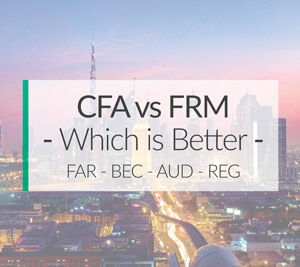
Both the Chartered Financial Analyst (CFA®) and Financial Risk Manager (FRM) credentials designate professionals who are knowledgeable in finance and capable of analyzing investments.
Although both certifications are financially based, they are very different in nature and allow their holders to perform different tasks and specialize in different activities.
Let’s take a look at CFA® vs FRM and see which one is right for you.
What is the difference between a CFA® and FRM?
What is a CFA®?
CFA® stands for Chartered Financial Analyst, a certification earned through the CFA® Institute. CFA®s exhibit a high level of expertise in investment management. Some of the job titles held by CFA®s include portfolio manager, research analyst, and investment banker. They also tend to work in corporate finance.
What is an FRM?
FRM is an acronym for Financial Risk Manager, a certification offered by the Global Association of Risk Professionals. GARP and the FRM certification are recognized internationally. FRMs assess an organization’s risk and develop strategies to minimize or offset it. They can be found working in banking, corporations, asset management firms, and government.
CFA® vs FRM Career Path Differences
CFA®s typically have more career opportunities than FRMs because their studies and skills are broad in scope, especially in managerial positions. They specialize in managing and maximizing a firm’s investments, which can cast a wide net career-wise. CFA®s typically work in hedge funds, investment banks, and corporate finance doing investment banking, portfolio management, and equity research.
FRMs, on the other hand, are much more specialized. They specialize in analyzing risk and figuring out ways to minimize it within a company or portfolio. FRMs typically hold managerial and executive level positions who concentrate on risk and investment risk.
CFA® vs FRM Certification Time Requirements
CFA® candidates must enroll in the certification program offered by the CFA® Institute. To enroll in the program, you must have a four-year degree or combination of education and work experience and pass a three-part exam covering the following topics:
- Ethics
- Portfolio Management
- Accounting
- Corporate Finance
- Fixed Income
- Equity Investments
It’s a common statistic that it requires about 300 hours of study time to pass each level of the CFA® exam. In addition, to receive the charter, you need to have fours years of related work experience under a CFA®. You must also become a member of the CFA® Institute.
To become an FRM, you must pass a two-part exam administered by the Global Association of Risk Professionals (GARP) twice each year covering the following topics:
- Quantitative Analysis
- Derivatives
- Value at Risk
- Credit Risk
- Operation Risk
- Basel Norms
FRMs must also complete two years of related work experience. It typically takes FRM candidates at least 150 hours to study for each exam level. GARP also encourages FRMs to take 40 hours of continuing education every two years. While the GARP website does not mention any specific four-year degree requirement or the minimum number of credit hours, you can assume that to hold a job in risk management, a bachelor’s degree would be necessary.
To earn either certification, be prepared to invest considerable time studying and investing in your exam preparation.
CFA® vs FRM Cost of Certification
The CFA® exam has a one-time program enrollment fee of $450. The total exam fees for each level typically cost $930. CFA® candidates can expect to pay $1,100 – $1,700 to obtain their charter.
To take the FRM exam, be prepared to pay a $400 enrollment fee in addition to the costs of each exam. Part I costs $875 and Part II costs $475. You can expect to pay $1,050 – $1,500 to become an FRM.
Pass rates for both exams are in the 40 percent range.
FRM and CFA® Potential Salaries
Salaries for both professions depend on the job title, years of experience and geographic location.
CFA®s can earn a salary between $45,000 and $180,000 per year depending on their position, experience, and industry. The FRM salary range is very similar to the CFA® salary range. FRMs typically earn $50,000 to $165,000.
FRM or CFA®: Why not have Both?
There is no reason why you can’t have both. It all depends on what you want to do with your career. The most logical scenario for having both a CFA® and FRM credential is if you are a CFA® and would like to specialize in risk management.
Remember, the FRM designation is way more specialized than the CFA®. Thus, it could be advantageous to have both. Keep in mind that both of these certifications are extremely difficult and time-consuming to achieve.
I would recommend that look at what you want to do with your career and pick one. Then after you start your career, you can decide if it would be beneficial to pursue another one.
CFA® vs FRM – Which is better?
Both designations are equally respected internationally. Both CFA®s and FRMs are supplicated financial professionals. Thus, neither one is better than the other. They are simply different.
While the CFA® designation is broader in scope and is weighed heavily toward investments, the FRM focuses solely on assessing and managing the risk of an organization. Which career path is preferable for you will totally depend on where your interests lie and what you enjoy doing more.
CFA® Institute does not endorse, promote or warrant the accuracy or quality of AIS-CPA.com. CFA® and Chartered Financial Analyst® are registered trademarks owned by CFA® Institute.












